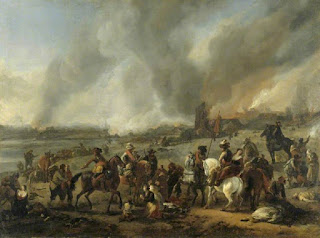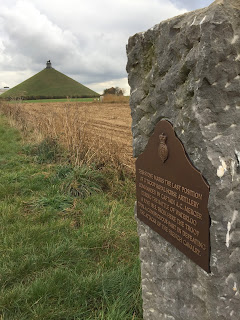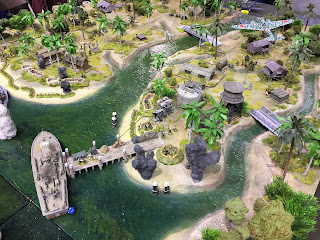“Then, when it appeared they were going to put siege to Maastricht, they camped, some at Montenaken, others at Laneken, and a large part of the army here at Emael. The Marques of Salada lodged here with three regiments, one of foot, and two of cavalry. They behaved worse than barbarously: they destroyed everything: they cut trees, completely demolished many houses, and trampled whatever grain they did not steal, not even leaving enough for the hunger of the poor farmers” (Priest at Emael, 1632)
I’ve always been envious of roleplaying supplements which describe in loving detail the background, political and economic environment, demographic features, weather and geographical context of the world in which the player characters’ undertake their adventures. Everything is to hand, and the characters exist in a world which really lives and breathes. Information which people in that world would immediately know can be looked up, or simply made up.
Real life history isn’t like that, at least not in the more obscure periods of history which wargamers sometimes like to visit. Those kinds of details which might be obvious to historical contemporaries can be difficult to track down, scattered over dozens of books. Which are the main population centres, and did they serve as viable winter quarters for assembling armies? Why was a particular town so attractive to armies looking to establish an encampment? Which was the lowest point on the river which was bridged in 1688? Where were the rural areas in which armies were marshalled, and how did this correspond with good foraging opportunities? Answering such questions can add a lot of context to our understanding of how any military campaign developed.
These are questions which would be obvious to a 17th Century general, but often are lost to us. Reconstructing that lost world takes time. Once you stray off the beaten English-language path, and into the dustier periods of history, you find that sooner or later you’re forced to rely on academic studies, the primary focus of which is not military history, let alone wargaming.
“War and Rural Life in the Early Modern Low Countries” by Myron P. Gutmann is one of those academic studies. It is most definitely not a military history book. I am sure that you could successfully wargame any campaign in North West Europe in the late seventeenth century without ever reading it.
But it does include a host of invaluable information about 17th century campaigning and warfare which has never its way to the more general military history books for the period. And a great deal of that information helps provide answers to those questions which a 17th Century general may well have just simply known, but which have been lost to us a long time ago.
Published in 1980, by Princeton University Press, “War and Rural Life in the Early Modern Low Countries” is not hard to find on the various second hand online book sites. I picked mine up from ABE Books for around £10.
It focuses on the region between Liège and Maastricht along the banks of the Meuse River known as the Basse-Meuse. The region was a magnet for armies in the 17th Century. In addition to the ‘Spanish Road’, the important military corridor through which Spanish armies marched from Italy and Southern Germany to the Low Countries, the Basse-Meuse was strategically central to the designs of Dutch Stadtholders and French Kings. The passage and visitation of armies into the region was also encouraged by a complex sovereignty and internal divisions among the leading noble families of the Basse-Meuse. The principality of Liège was the dominant sovereign of the area, being a significant ecclesiastical principality not incorporated to the Dutch Republic or the Spanish Netherlands. Formally a neutral player during international disputes, the position of the principality became increasingly complicated and vulnerable in the late 17th Century, as France and Holland both exerted influence and attempted dominance in the area.
We may be able to tell this from casting a careful eye over any map of the region, and one of the general history books of the 17th Century. However, Professor Gutmann’s book tells us a lot more. He examines what brought armies to the Basse-Meuse in the late 17th century. Not to fight, but to use the area as a route for armies travelling through the region, either west to the Spanish Netherlands, east to Germany, or north to Holland. The River Meuse was a central route for transporting troops, not just as part of the Spanish Road used in the early 17th century, but still critical as a route by which troops could march along while their artillery was floated down the Meuse on barges. Such tactics gave the river a vital strategic capability for north/south movement.
The Basse-Meuse region was also important for east/west transport. The land was flat, relatively unwooded, with key bridges at Liege and Maastricht (the Meuse not being bridged further north than Maastricht in the 17th Century). Shallow water crossing points also existed on the Meuse at points between Liege and Maastricht, at Visé, Argenteau and Herstal. Maastricht in particular became a central strategic location for control of the River Meuse. Major sieges were mounted in 1632 (by the Dutch against Spanish defenders), 1673 (by the French against the Dutch) and 1676 (by the Dutch against the French), and the visits of armies to the region to mount these sieges led to some of the most challenging conditions in the region for local civilians. Importantly for such visiting armies, another attraction of the region was that there were no natural barriers to keeping armies out. “Flat, virtually unarmed, and riven by internal disputes, the Principality could not resist being crossed or occupied, frequently with dire consequences for its finances and citizens” (page 17).
The region was rich in farmland, grain, cattle and the industrial goods needed to supply armies. Liège in particular was well known as a centre of heavy industry, producing iron and coal, and manufacturing guns, armour and military equipment. “This armies that came and camped around Liège could find not only full granaries, but could leave with all the new weapons they needed, provided by the obliging craftsmen and gun-merchants of Liège and its neighbourhood” (26). Any army camped near the City of Liège could rely on being well supplied for the following campaign. Also, while armies in the 17th Century did not generally fight in the winter months, they did not disband. They attempted to find a place to make winter quarters. And it was wintering armies, quartered in in transitory, winter camps and lodging with the local communities in the villages and smaller hamlets of the Basse-Meuse which were the real scourge of the region.
In such an environment, “military incursions exacerbated weaknesses in the Basse-Meuse economy” although such incursions did not inevitably result in destruction. Military presence focused local attention on attempting to profit from the relationship with military actors. “The result was a socially and economically healthy society that was capable of surviving the potential hardships associated with repeated and protracted military operations” (page 27).
Much of the rest of the book is a detailed examination of this relationship, and has a mine of information for anyone looking to stage a campaign set in the 17th century. The sections of the book focusing on the billeting of military forces in local villages are particularly striking. “Barracks hardly existed before 1600, and troops rarely carried tents with them. Rather, if an army was going to be in one place for a week or more, especially in winter, soldiers slept in the homes (and probably barns) of the citizens” (page 36). Such billeting could be hugely burdensome on local societies, with requirements for food, clothing, wagons, livestock and wagon-drivers all being significant. The book goes on to describe many examples of the burdens of military quartering, coupled with the other consequences of living in a conflict zone such as raiding, the forcing of ‘contributions’ from civilians and the negotiation of bribes to secure smooth passage of armies.
Reading these accounts brings home a rich context of an army’s relationship with the land on which campaigning took place. Some armies would be accommodating, seeking a mutually profitable relationship with the civilian leaders of the various communes of the region. Some armies would be brutal, (like the quotation at the start of this blog post) calculating that the murder of a foraging party might be an acceptable price for levying greater contributions. Of course, there was always the possibility of devastating the land as an army marched through it - although, as commanders in Germany in the Thirty Years War had ultimately found, no army could live off the land once the people had been driven away.
Gutmann explores the changes in military organisation in the 17th century in tandem with the changing approaches that army commanders had towards the civilian population of the Basse-Meuse. Famous commanders such as Duke Charles IV of Lorraine and the Prince of Condé drift into the narrative at various points as the high-water mark of the war-by-devastation approach in the Basse-Meuse, their noble-dominated, quasi-mercenary forces soon to replaced by national armies with greater resources and enhanced discipline. The late seventeenth century developments in military discipline and in the housing and feeding of troops, lay more in the need for larger, effective fighting forces than in any desire for the well-being for civilians living in the conflict zone. However, the consequence was a far more complicated and nuanced relationship between the armies moving through the region, and the civilians living there.
For those looking for detailed economic data to underpin any campaign, there are numerous graphs and charts in the book. There is a chapter concerning the fluctuation of grain prices as a result of varying stages of conflict, introduced by Professor Gutmann’s question: “Did prices respond to the lessening of military destruction at the end of the seventeenth century?”
OK, OK… I know, that’s a long way from thinking about push-of-pike, and even longer from thinking about rules mechanics for cavalry charges in wargames. And I’m not suggesting that Professor Gutmann’s detailed economic arguments (extensively researched and beautifully written) will be every wargamer’s ideal New Year reading material. But, if you’re interested in the working of local rural economies in an early modern conflict, the book is a gold mine of information and a wonderful read.
Yes, this is one of those books - maybe not a page-turner as regards rushing to the end to find who won the battle, but certainly a terrific research source to return to again and again.
There’s a very useful 17th Century chronology to the region, allowing you to chart the progress of armies through the region each year by number, commander, location and nationality. Most useful of all is a guide to the historical weather experienced in each year, together with details of epidemics and diseases in the region and the locations where these happened. Anyone keenly searching out orders of battle and curious regarding the locations of encampments and winter quarters will find a lot of good information in the chronology section of the book.
A later chapter considers the degree of depopulation associated with conflict in the 17th century in the Basse-Meuse region. The story of the region in this regard is, surprisingly, of resilience of the population in the face of war. Unlike the population of areas of Germany, the Netherlands, Luxembourg, Lorraine and the Duchy of Burgundy which suffered heavily from militarily related depopulation, the population of the Basse-Meuse was relatively stable in the later 17th century. Gutmann’s exploration of why this was the case forms a key section of the book, alongside a number of insights into the correlation between disease, bad harvests, military action and the peaking of rural deaths in the months of September, October, and November each year. Over-work, malnutrition and the infectious diseases accompanying a visiting army could frequently have a deadly effect on local populations - perhaps another event worth including or referencing in war-games campaigns of the period. One notable event I spotted was that in the late summer of 1676, the local chronicler de Sonkeux noted that a mechante dissenterie (wicked dysentery) was to be blamed on a French pillaging expedition. If that’s not an authentically historical campaign chance card waiting to be written, I don’t know what is.
And to my mind, this is what is wonderful about this ostensibly rather dry, academic book. Reading through the book the reader is simply immersed into a lost, forgotten world which fell outside the frontiers of the rapidly growing powerful states of France and the Dutch Republic. There are numerous anecdotes which bring the region of the Basse-Meuse to life, alongside more than enough information to create a viable historical background to any wargaming campaign set in the region in the 17th Century. Just as we might research flags, uniforms, formations and tactics, there’s no reason we, as wargamers, cannot also research the background to, and impact of, campaigning in the historical world where such wars took place.
As I mentioned at the start of this post, I’ve always enjoyed RPG campaigns with a deep setting of place and region - whether urban or rural - and I've always been more than slightly envious that wargaming campaigns have not often been available which provide the same background information. In wanting to correct that imbalance, this book is a great start.
Highly Recommended.




















































